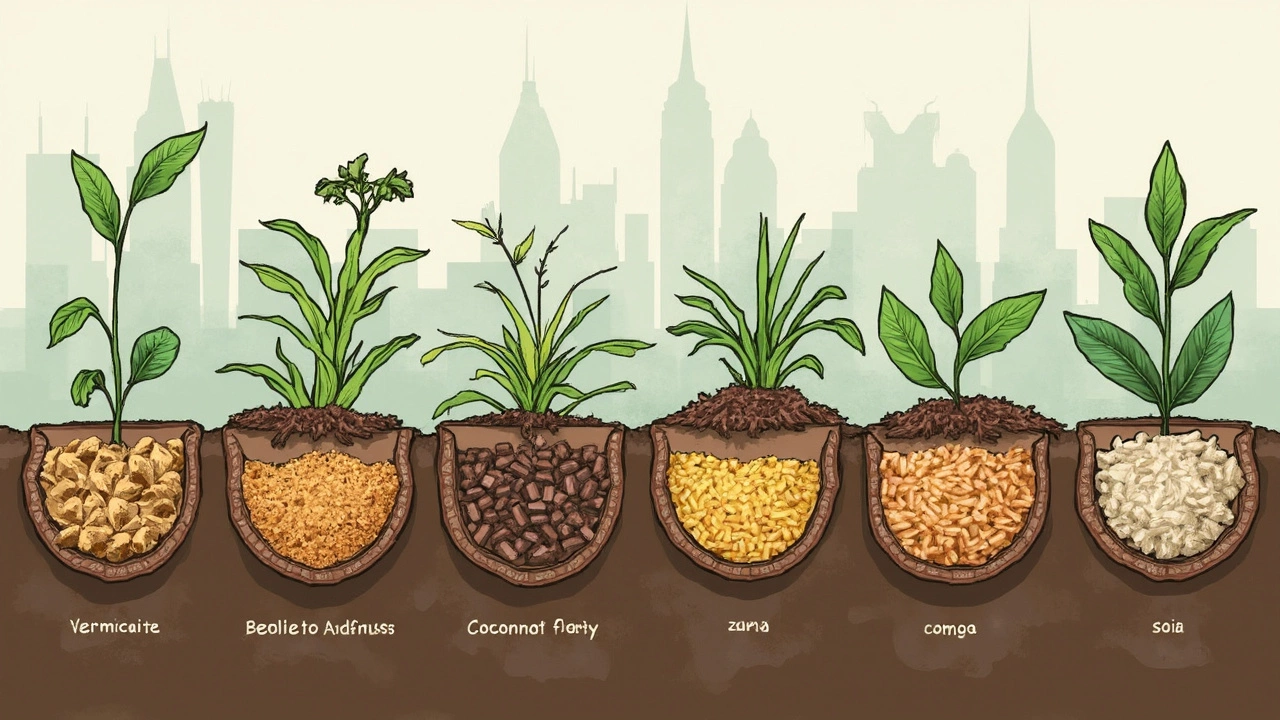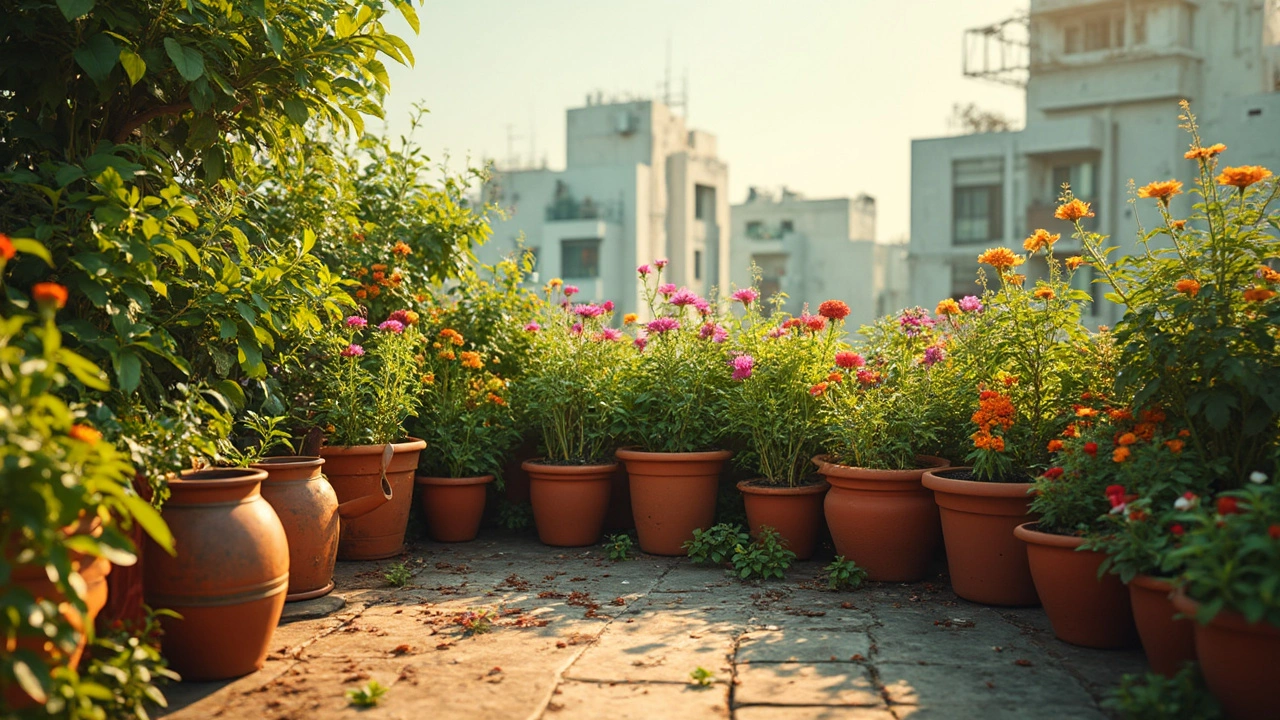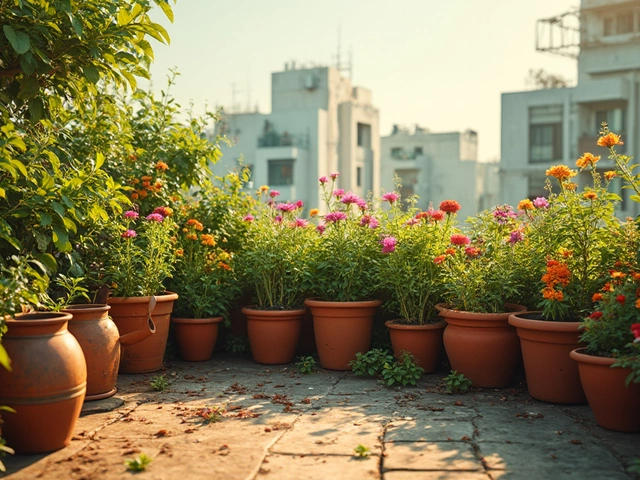Starting a rooftop garden sounds like an urban gardener’s dream, right? But have you ever thought about what your green paradise actually needs? It’s not as simple as grabbing some soil from the nearest park. Rooftop gardening requires a special soil mix that tackles weight, drainage, and nutrient issues all at once.
Why is this mix so crucial? Well, rooftop gardens have unique needs compared to your backyard beds. You’re dealing with a space that can’t bog down with too much weight. Plus, water management doesn’t come easy when you're just a few inches away from turning your building into a waterfall.
So, where do you start? Think about the foundation—a balanced mix of materials like compost, perlite, and vermiculite. You’ll need something that won’t stress out the building’s structure but still offers your plants the buffet of nutrients they crave.
- Understanding Rooftop Constraints
- Key Components of Soil Mix
- Optimizing Drainage and Aeration
- Nutrient Management for Rooftops
- Lightweight Alternatives for Soil
- Maintenance Tips for Rooftop Gardens
Understanding Rooftop Constraints
So you've got a rooftop garden planned out, but you're wondering what limitations you might face up there? First up, it’s crucial to understand your rooftop’s load-bearing capacity. Not all roofs are created equal. Some can handle a meadow, while others might buckle under a few pots of petunias.
Weight Limit Considerations
Rooftop garden design starts with weight. Your soil mix and plants add quite a bit of pressure. Consult an engineer to figure out just how much weight your setup can pack on. It’s not just about the soil; pots, planters, and even furniture contribute to the load.
Weather and Wind
Being up high has its perks, but it opens your rooftop garden to harsher conditions, too. Wind is a major player - strong gusts can damage plants or even blow them away! Anchoring plants and choosing more wind-resistant varieties can save you heartache.
Water Drainage and Access
One of the trickiest aspects is water management. Unlike the ground, a rooftop doesn't soak up excess water. Ensure you have a robust drainage system in place to keep water from pooling or running over the edge. Access to water sources is another factor. Consider how you’ll transport water to the roof or if you’ll have access to nearby hookups.
| Constraint | Solution |
|---|---|
| Excess Weight | Engineer consultations, lightweight soil alternatives |
| Wind Exposure | Plant selection, windbreaks |
| Drainage Issues | Proper drainage installation, container choice |
Okay, so you've got the rocking rooftop garden idea, but keep these constraints in mind. With a little planning, and the right techniques, your urban oasis will flourish against these odds. Keep that vision in your mind, and don’t skimp on the vital preparations.
Key Components of Soil Mix
Creating the perfect soil mix for a rooftop garden is like assembling a crew of superheroes. Each ingredient has its own special power, and together, they create a thriving environment for your plants. Let's break down these crucial components and see what makes them tick.
Organic Matter
First up, we have compost—the organic matter champion. This stuff is rich in nutrients, helping your plants grow healthy and strong. Compost also improves soil structure and retains moisture, which is a big win when you’re battling that rooftop breeze.
Drainage Heroes
Here's where perlite and vermiculite come in. These volcanic heroes keep your soil mix light and airy, ensuring proper drainage and preventing waterlogging. Think of them as the gym trainers of your soil, keeping it buff and ready for action.
Nutrient Boosters
Don’t forget about the nutrients! Besides compost, fertilizers can be sprinkled in to boost growth. Consider slow-release forms that provide steady nourishment over time without overwhelming your plants. Think of them as the protein shakes for your rooftop stars.
Lightweight Alternatives
If you’re really concerned about weight, coco coir is a fantastic substitute. This coconut husk fiber is light, retains moisture well, and is eco-friendly. It’s your soil's featherweight champion, perfect for when you’re working with stricter weight limits.
| Component | Function | Suitable for Rooftop? |
|---|---|---|
| Compost | Nutrient addition | Yes |
| Perlite | Improves drainage and aeration | Yes |
| Vermiculite | Retains moisture | Yes |
| Coco Coir | Lightweight moisture retention | Yes |
These components together form a superhero squad for your rooftop garden, each playing its role to support plant health and growth. If you balance these elements right, you’ll have a soil mix that’s lightweight yet nutritious, setting the stage for a flourishing urban garden.
Optimizing Drainage and Aeration
Anyone who's tried rooftop gardening knows that getting drainage right is one of the biggest challenges. Why? Because poor drainage can lead to overwatering, which is basically a death sentence for plants. So what can you do to prevent this?
Focus on Effective Drainage
Your best bet is to mix in materials like perlite and sand, which improve drainage. Perlite, those little white beads, might look like plastic foam but work wonders by keeping water from pooling. Sand, on the other hand, provides those extra channels for water to escape, helping avoid saturation.
Boosting Aeration
Aeration is your plant roots' best friend. You don’t want compacted soil because it limits airflow to the roots. Adding coarse materials like bark or coconut coir can make a world of difference. These elements keep the soil loose and full of air pockets, letting roots breathe easy.
The Role of Containers
Let’s not forget the container you use matters just as much. Opt for ones with plenty of drainage holes. If you’re making your containers, think about adding layers—like rocks at the bottom—to stop soil from slipping out while still letting water drain.
Curious about whether your drainage is up to the mark? It’s easy: Pour water in and see if it drains within a few minutes. If it hangs around for longer, it’s time to tweak your soil mix or container.
| Component | Role in Drainage & Aeration |
|---|---|
| Perlite | Prevents water pooling |
| Sand | Create water escape channels |
| Bark | Improves soil aeration |
| Coconut Coir | Keeps soil loose |
Making sure your garden has top-notch drainage and aeration doesn’t just help plants thrive, it also means less hassle for you and more time enjoying that urban green space without worry!

Nutrient Management for Rooftops
Keeping your rooftop garden lush and thriving requires a careful approach to nutrient management. This isn't just about tossing in some fertilizer. It’s about understanding the unique needs of your elevated greenery.
Choose the Right Fertilizer
Fertilizers come in all shapes and sizes, and picking the right one can make a world of difference. You want to look for a balanced N-P-K (Nitrogen-Phosphorus-Potassium) ratio. A common recommendation is a 10-10-10 mix, which offers a bit of everything your plants need.
For those growing edibles on their rooftop gardens, organic options like compost tea or fish emulsion can be gentle yet effective. They’re great for promoting strong, healthy growth without the harsh chemicals.
Application Tips
How you apply your nutrients is just as important as what you use. Frequent, small applications are often better than a big dump all at once. This method helps avoid nutrient runoff and ensures that your plants aren't overwhelmed.
Consider using a slow-release granular fertilizer, which does wonders for longer-term feeding. Just sprinkle it around, and let it do the work over time.
Soil Testing and Monitoring
Even if you think your soil is in tip-top shape, it never hurts to double-check. Soil testing kits are a handy tool for assessing the current nutrient levels and pH balance. With this info, you can tweak your feeding routine to what the plants specifically need.
Pay attention to signs of nutrient deficiencies. Yellowing leaves, slow growth, or poor fruit production can hint that something is off balance.
| Common Deficiencies | Signs |
|---|---|
| Nitrogen Deficiency | Yellowing leaves, especially at the bottom |
| Phosphorus Deficiency | Dark, purplish tint on older leaves |
| Potassium Deficiency | Yellow leaf edges, spots |
Composting on Rooftops
If you're up for a little DIY, composting is a fantastic way to keep nutrients flowing. A small bin can handle kitchen scraps and garden waste, turning them into rich compost that you can mix back into your soil. It's a natural and sustainable way to feed your rooftop garden.
Remember, consistency is key! Regularly monitor and adjust as needed to maintain a vibrant, healthy urban oasis.
Lightweight Alternatives for Soil
When it comes to building a rooftop garden, using the right soil mix that’s not too heavy is super important. You want your garden to be lush without risking your building’s integrity, right? Well, there are some awesome lightweight soil alternatives that keep things light and breezy up there.
What's the Deal with Lightweight Soil?
The trick is to find materials that are not only lighter than traditional soil but can also provide good drainage and nutrition. That’s where stuff like perlite, vermiculite, and coconut coir come in. These aren't just random fillers; they’re little lifesavers for your garden.
Perlite is like volcanic popcorn. It’s puffed up through heating and doesn’t weigh much at all. Plus, it helps soil retain just the right amount of water without getting soggy.
Vermiculite, on the other hand, is a bit like a sponge. It holds water really well and is great if you need more moisture retention.
Coconut coir, made from coconut husks, is another superhero. It’s eco-friendly, very lightweight, and helps with both aeration and water retention.
Mixing It Up
Creating your own mix? Think of combining these materials with compost for nutrients. Here’s a simple mix to get you started:
- 40% or so of compost for nutrients.
- 20% perlite for aeration.
- 20% vermiculite for water retention.
- 10-20% coconut coir for structure and extra lightweight benefits.
This mix is just a guideline and you can totally tweak it based on your plants’ needs. Some plants might demand more drainage, while others might need more moisture.
Keep It Light, Keep It Green
Finding the right balance in your soil mix is key to having a thriving rooftop garden. Being mindful of weight doesn't mean compromising on plant health. With these smart tweaks and lightweight soil alternatives, your urban oasis can flourish above the city skyline easily.
Maintenance Tips for Rooftop Gardens
So, you've set up your dreamy green space on the roof. What next? Like any garden, a rooftop garden needs regular love and care. But with it being a bit of an unusual setup, there are some special things to keep in mind.
Watering Wisely
Rooftop gardens are more exposed to the elements, meaning they can dry out faster. It's all about finding the right balance. Too much water can be as harmful as too little. Most experts suggest using a drip irrigation system because it provides consistent moisture without flooding your plants.
"A well-placed irrigation system can be a city gardener's best friend," says urban gardening consultant Lisa Martin.
Regular Soil Checks
Given the drainage needs of a rooftop setup, you’ll want to check the soil’s moisture and nutrient levels regularly. The components in your soil mix will gradually deplete, so keep an eye on that.
Wind Protection
The heightened location makes plants more susceptible to wind damage. To combat this, consider setting up windbreaks or trellises, which can also double as supports for climbing plants.
Fertilizing Schedule
Nutrient maintenance is key. Use slow-release fertilizers that suit your plants’ needs. Monthly feeding during the growing season can help maintain the garden's vitality.
- Choose organic fertilizers to avoid chemicals.
- Avoid over-fertilizing to prevent runoff issues.
Winterizing
In colder months, protect your rooftop garden by insulating containers and adding mulch layers. Consider moving tender plants indoors temporarily if possible.
Pest Management
Keep an eye out for pests that might think they've found a nectar-filled haven. Organic pesticides or even natural deterrents like garlic or neem oil can keep them at bay.
By following these maintenance tips, you'll not only keep your rooftop garden thriving but also enjoy the satisfaction of watching it flourish in the urban skyline.




